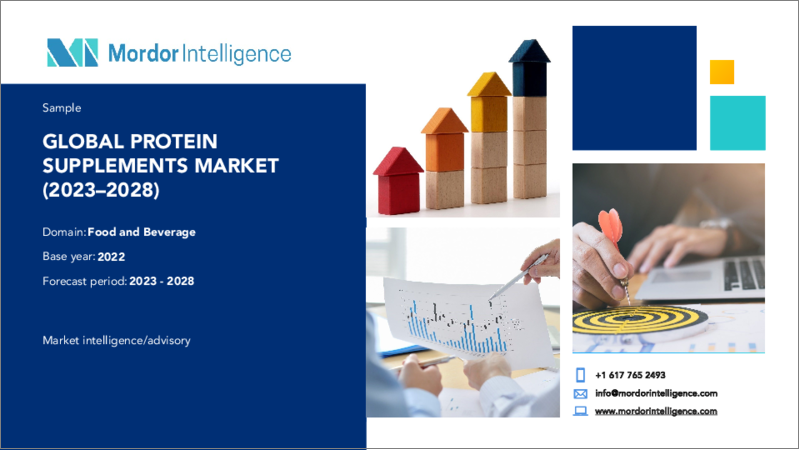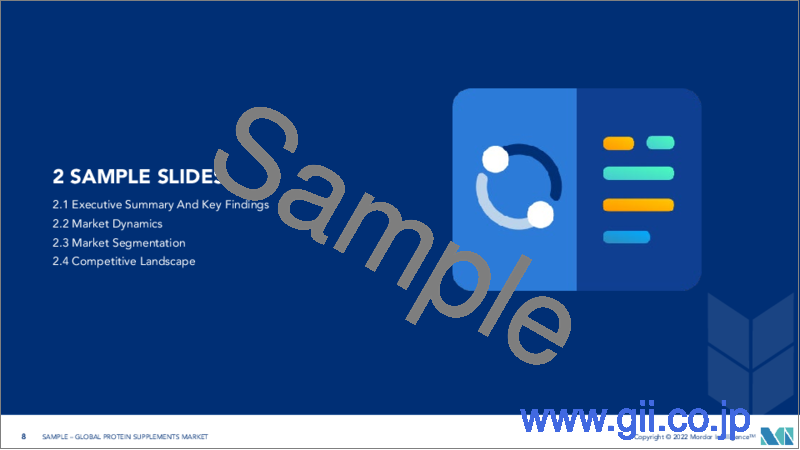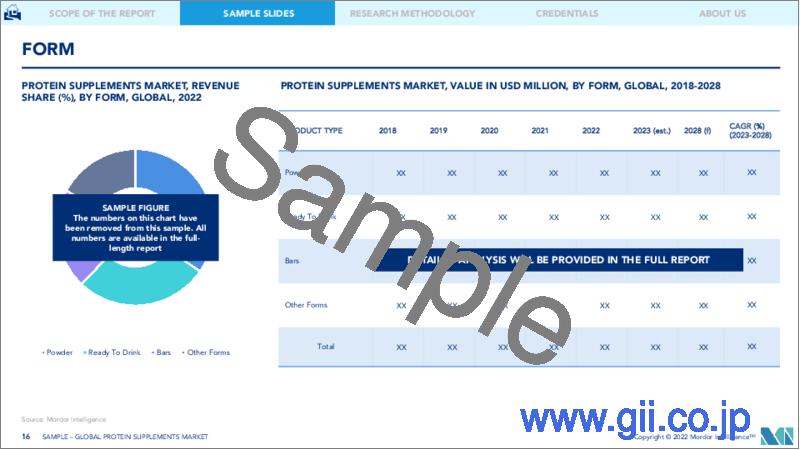|
|
市場調査レポート
商品コード
1333648
プロテインサプリメント市場規模・シェア分析- 成長動向と予測(2023年~2028年)Protein Supplements Market Size & Share Analysis - Growth Trends & Forecasts (2023 - 2028) |
||||||
|
● お客様のご希望に応じて、既存データの加工や未掲載情報(例:国別セグメント)の追加などの対応が可能です。 詳細はお問い合わせください。 |
|||||||
| プロテインサプリメント市場規模・シェア分析- 成長動向と予測(2023年~2028年) |
|
出版日: 2023年08月08日
発行: Mordor Intelligence
ページ情報: 英文 160 Pages
納期: 2~3営業日
|
- 全表示
- 概要
- 目次
プロテインサプリメント市場規模は、2023年に252億1,000万米ドルと推定され、2028年には367億米ドルに達すると予測され、予測期間中(2023-2028年)にCAGR 7.80%で成長する見込みです。
プロテインサプリメントは、筋肉の成長、代謝、エネルギーレベル、心臓の健康、体重管理など、身体の様々な側面に影響を与えるため、ジム愛好家やフィットネス愛好家の間で人気があります。謳い文句、タンパク質含有量、供給源、形状、風味など、プロテイン・サプリメントの多様性は、世界中の幅広い消費者層に対応し、市場を活発に牽引しています。予測期間中も引き続き勢いを増すと予想されます。さらに、植物性タンパク質に対する需要の高まりは、オーガニックでクリーンラベルのプロテインサプリメントを市場チャネルに提供するようメーカーを後押しすると予想されます。
COVID-19の発症に伴い、プロテイン・サプリメントは、免疫力を高める明らかな能力で注目されるようになっています。栄養製品の主要メーカーであるGlanbia PLCが2020年4月に米国で食品と栄養製品に支出する消費者へのCOVID-19の影響を追跡するために実施した2週間の調査によると、健康を維持し免疫力を高めるためにプロテインバーを消費する回答者の割合は、2020年3月の第1週の21%から第2週の23%に増加しました。また、すぐに飲めるプロテインシェイクの消費量も、パンデミック後に大幅に増加しました。
さらに、スポーツ活動の隆盛、有名人の推薦、国際的なスポーツやフィットネスのイベント、ソーシャルメディアのインフルエンサー、政府の様々な取り組みやキャンペーンは、消費者が様々なフィットネスやスポーツ関連の活動に参加することを促し、健康的なライフスタイルを維持するための支出の増加に寄与しています。
しかし、プロテイン・サプリメントを含むスポーツ栄養カテゴリーにおける政府の監視は、市場に導入される製品のタイプに影響を与え続けています。適切なガイドラインや規制の枠組みがないため、多くのプロテインサプリメントの回収が発生しています。
プロテインサプリメント市場の動向
市場の多様性と製品革新がプロテインサプリメントの需要を促進
- プロテインは、競争力を高めたいアスリート、筋肉量を維持したい高齢者、他のプロテインサプリメントタイプの中でも食事代替のプロテインパウダー、バー、シェイクを選ぶ多忙な個人など、あらゆる消費者の間で人気のある多量栄養素となっています。このような要因が、世界的にプロテインサプリメントの売上と消費を押し上げています。
- 例えば、Office for National Statistics(英国)によると、2021年に濃縮プロテインの販売額は4億6,300万万ポンド(6億3,431万米ドル)を超え、2020年の4億3,900万ポンド(6億143万米ドル)から増加しました。さらに、炭水化物や糖質よりも脂肪やタンパク質を重視するパレオ、ケトジェニック、Whole30のような特殊な食事動向が、タンパク質の摂取量を評価し、新たな供給源を求める人々の増加を余儀なくしており、これが世界中のプロテインサプリメント需要を支えています。
- 性別、年齢層、目標などが異なる消費者の増加に伴い、市場は多様化しています。健康、ライフスタイル、価値観の異なる様々な背景を持つ消費者が、より多くのタンパク質を食事に加え続けているため、企業は急増する需要を満たすために、高タンパクで複数のフレーバーを持つ革新的なプロテインサプリメントやその他の機能性栄養製品を処方しています。
- 例えば、2022年3月、スポーツ栄養とライフスタイルブランドの栄養補助食品をリードする世界的プロバイダーであるマッスルファームは、複数の無糖フレーバーで20g以上のタンパク質を含む高ホエイタンパク飲料ライン(Ready-To-Drinkプロテイン飲料)を発売しました。
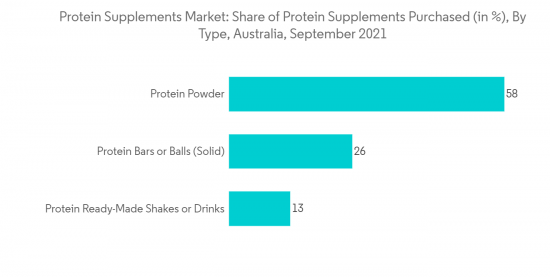
アジア太平洋地域が市場で大きなシェアを占める
- アジア太平洋地域は市場で大きなシェアを占めており、若い消費者の割合が高く、可処分所得水準が上昇しているため、近年急成長を遂げています。中国が同地域の成長をリードすると予想されているが、これは、住民がより活動的で健康的なライフスタイルを送るための手段として、スポーツやフィットネス活動への参加増加を促進する政府の取り組みによるものです。中国政府は、中国をスポーツ大国へと変貌させるため、フィットネス普及のための政策やプログラムを実施してきました。
- 例えば、政府は2021年末までにスポーツ施設の数を397万に拡大し、その面積は34億1,000万平方メートルに及び、スポーツ施設の1人当たりの面積を2.41平方メートルに拡大しました。また、スポーツ総局は1,200~1,400のスポーツ会場を後援し、一般市民が無料または安価で利用できるようにして、より多くの人々がスポーツに参加したり、定期的に運動したりして身体の健康を維持するよう奨励しています。
- さらに、中国スーパーリーグやASEANバスケットボールリーグを含む様々なスポーツリーグの台頭と浸透の高まりは、フィットネスとアクティブなライフスタイルの文化を創造し、それによって中国のプロテインサプリメント市場を牽引しています。
- 多くのアジア諸国では、消費者のライフスタイルに明らかな変化が見られ、より多くの人口が体力維持のためにスポーツ、マラソン、ジム、フィットネスクラブ、トレッキングなどに頻繁に参加するようになっています。この動向により、多くの消費者が、運動前や運動後に数多くのプロテインサプリメント製品を採用するようになっています。
- 例えば、Food Science and Nutrition Technologyが発表した調査によると、マレーシアでは、2021年にジムで運動するサプリメントユーザーのうち、約73.7%の消費者がプロテインシェイクを好み、68.3%がホエイプロテインを好んでいます。
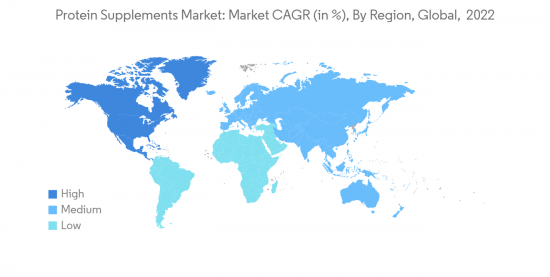
プロテインサプリメント産業の概要
世界のプロテインサプリメント市場は断片化されており、多くの地域的・世界的プレーヤーが存在します。大きな市場シェアを持つ企業には、Glanbia PLC、Mondelez International Inc.、明治ホールディングス、Post Holdings, Inc.、The Hut Groupなどがあります。各社は市場での地位を維持するため、研究開発(R&D)やマーケティングへの投資を増やし、流通チャネルを拡大しています。
さらに、新世代の顧客の嗜好や嗜好に合わせた製品を開発するためにより多くの投資を行い、競争戦略を採用しています。強力な製品ポートフォリオとともに、各社はパートナーシップ、合併、買収など様々な企業戦略を駆使してプロテイン・サプリメント市場に参入しています。
例えば、2021年11月、シックス・スター・プロ・ニュートリションは、米国サッカー代表選手で欧州のスター選手であるウェストン・マッケニーとパートナーシップを結び、ピッチ内外でアクティブな栄養摂取を推進することを発表しました。
その他の特典:
- エクセル形式の市場予測(ME)シート
- 3ヶ月間のアナリストサポート
目次
第1章 イントロダクション
- 調査の前提条件と市場定義
- 調査範囲
第2章 調査手法
第3章 エグゼクティブサマリー
第4章 市場洞察
- 市場促進要因
- 市場の多様性と製品革新がプロテインサプリメント需要を促進
- フィットネスとスポーツ文化の成長
- 市場抑制要因
- 製品リコールの増加が市場成長の脅威となる
- 業界の魅力- ポーターのファイブフォース分析
- 供給企業の交渉力
- 買い手の交渉力
- 新規参入業者の脅威
- 代替品の脅威
- 競合の程度
第5章 市場セグメンテーション
- 形態
- 粉末
- レディ・トゥ・ドリンク
- バー
- その他の形態
- ソース
- 動物性
- 植物性
- 流通チャネル
- スーパーマーケット、ハイパーマーケット
- 薬局・ドラッグストア
- 専門店
- オンライン小売店
- ジム・ヘルスクラブ
- その他の流通チャネル
- 地域
- 北米
- 米国
- カナダ
- メキシコ
- その他北米地域
- 欧州
- 英国
- ドイツ
- フランス
- イタリア
- ロシア
- スペイン
- その他欧州
- アジア太平洋
- 中国
- 日本
- インド
- オーストラリア
- その他アジア太平洋地域
- 南米
- ブラジル
- アルゼンチン
- その他南米
- 中東・アフリカ
- サウジアラビア
- 南アフリカ
- その他中東とアフリカ
- 北米
第6章 競合情勢
- 最も採用されている戦略
- 市場シェア分析
- 企業プロファイル
- Glanbia Plc
- Lovate Health Sciences International Inc.
- The Hut Group
- Scitec Nutrition
- Weider Global Nutrition Llc
- Abbott Laboratories
- Nestle SA
- Post Holdings, Inc.
- Meiji Holdings Co., Ltd
- Mondelez International Inc.
第7章 市場機会と今後の動向
The Protein Supplements Market size is estimated at USD 25.21 billion in 2023, and is expected to reach USD 36.70 billion by 2028, growing at a CAGR of 7.80% during the forecast period (2023-2028).
Protein supplements are popular among gym fanatics, and fitness enthusiasts, as they influence various aspects of the body such as muscle growth, metabolism, energy levels, heart health, and weight management. The diversity of protein supplements, in terms of claims, protein content, sources, forms, and flavors, is catering to a wide consumer group around the globe and driving the market actively. It is expected to continue gaining momentum during the forecast period as well. Additionally, the increasing demand for plant-based protein is expected to push manufacturers to bring organic and clean-label protein supplements across the market channels.
With the onset of Covid-19, protein supplements gained increased prominence for their apparent ability to enhance immunity. As per a two-week survey conducted by Glanbia PLC, a key nutrition products producer, in April 2020 to track the impact of COVID-19 on consumers spending on food and nutrition products in the United States, the percentage of respondents who consumed protein bars to stay healthy and boost immunity increased from 21% in week 1 to 23% in week 2 of March 2020. The consumption of ready-to-drink protein shakes also increased substantially post-pandemic.
Furthermore, the rising prominence of sports activities, celebrity endorsements, international sports and fitness events, social media influencers, and various government initiatives and campaigns, encourage consumers to participate in various fitness and sports-related activities, thus contributing to the increasing expenditure on maintaining a healthy lifestyle.
However, government scrutiny in the sports nutrition category, including protein supplements, continues to affect the types of products introduced to the market. The lack of proper guidelines and regulatory framework has resulted in many protein supplements recalls.
Protein Supplements Market Trends
Market Diversity & Product Innovation is Propelling Protein Supplement Demand
- Protein has become a popular macronutrient among all consumers, including athletes looking for a competitive edge, aging seniors intent on maintaining muscle mass, and busy individuals who are opting for meal-replacement protein powders, bars, and shakes, among other protein supplement types. This factor has been boosting the sales and consumption of protein supplements globally.
- For instance, according to Office for National Statistics (UK), in 2021, the sales value of protein concentrates surpassed GBP 463 million (USD 634.31 million), which increased from GBP 439 million (USD 601.43 million) in 2020. Additionally, specialty diet trends, like paleo, ketogenic, and Whole30, which emphasize fat and protein over carbohydrates and sugar, have compelled a growing number of people to assess their protein intake and seek out new sources, which in turn is supporting the protein supplement demand across the globe.
- The market has become more diverse with the growing consumer base, including people from different genders, age groups, goals, etc. As consumers from various backgrounds with varying goals of health, lifestyles, and values continue to add more protein to their diet, companies have been formulating innovative protein supplements and other functional nutrition products with high protein and in multiple flavors to satisfy burgeoning demand.
- For instance, in March 2022, MusclePharm, a global provider of leading sports nutrition and lifestyle branded nutritional supplements, launched a high whey protein drink line (Ready-To-Drink protein drink) with over 20g of protein in multiple sugar-free flavors.

Asia-Pacific Holds a Significant Share In The Market
- The Asia-Pacific region holds a significant share of the market studied and has witnessed rapid growth in recent years owing to a higher percentage of young consumers and rising disposable income levels. China is expected to lead the growth of the region, owing to government initiatives promoting increased participation in sports and fitness activities as a means for residents to lead active and healthier lifestyles. The Chinese government has implemented policies and programs for widespread fitness to transform China into a major sporting force.
- For instance, the government expanded the number of sports facilities to 3.97 million by the end of 2021, spanning an area of 3.41 billion square meters, and increased the per-person space for sports facilities to 2.41 sq m. The General Administration of Sport also sponsors 1,200 to 1,400 sporting venues so that the general public can access them for free or at a cheap cost to encourage more people to participate in sports or exercise regularly to preserve their physical health.
- Moreover, the increasing emergence and rising penetration of various sports leagues, including the Chinese Super League and ASEAN Basketball League, are creating a culture of fitness and active lifestyles, thereby driving the protein supplements market in China.
- In many Asian countries, there has been a discernible change in the lifestyles of consumers, as a larger population participates more frequently in sports, marathons, gyms, fitness clubs, and trekking activities to maintain their physical fitness. This trend has led many consumers to adopt numerous protein-supplement products, either for pre- or post-workouts.
- For instance, according to a study published by Food Science and Nutrition Technology, in Malaysia, around 73.7% of the consumers preferred protein shakes, and 68.3% preferred whey protein among supplement users exercising in the gym in 2021.

Protein Supplements Industry Overview
The global protein supplements market is fragmented, with the presence of a number of regional and global players. The players with substantial market shares include Glanbia PLC, Mondelez International Inc., Meiji Holdings Company, Post Holdings, Inc., and The Hut Group. Companies are increasing their investments in research and development (R&D) and marketing and are expanding their distribution channels to maintain their position in the market.
Furthermore, they are adopting competitive strategies by investing more to develop products according to the tastes and preferences of the new-generation customers. Along with a strong product portfolio, the companies use various corporate strategies like partnerships, mergers, and acquisitions to penetrate the protein supplements market.
For instance, in November 2021, Six Star Pro Nutrition announced a partnership with the United States national soccer team player and European star Weston McKennie to promote active nutrition on and off the pitch.
Additional Benefits:
- The market estimate (ME) sheet in Excel format
- 3 months of analyst support
TABLE OF CONTENTS
1 INTRODUCTION
- 1.1 Study Assumptions & Market Definition
- 1.2 Scope of the Study
2 RESEARCH METHODOLOGY
3 EXECUTIVE SUMMARY
4 MARKET INSIGHT
- 4.1 Market Drivers
- 4.1.1 Market Diversity & Product Innovation is Propelling Protein Supplement Demand
- 4.1.2 Growing Fitness and Sports Culture
- 4.2 Market Restraints
- 4.2.1 Increasing Number of Product Recalls Poses Threat to the Growth of the Market
- 4.3 Industry Attractiveness - Porter's Five Forces Analysis
- 4.3.1 Bargaining Power of Suppliers
- 4.3.2 Bargaining Power of Buyers
- 4.3.3 Threat of New Entrants
- 4.3.4 Threat of Substitutes
- 4.3.5 Degree of Competition
5 MARKET SEGMENTATION
- 5.1 Form
- 5.1.1 Powder
- 5.1.2 Ready To Drink
- 5.1.3 Bars
- 5.1.4 Other Forms
- 5.2 Source
- 5.2.1 Animal-based
- 5.2.2 Plant-based
- 5.3 Distribution Channel
- 5.3.1 Supermarkets & Hypermarkets
- 5.3.2 Pharmacies and Drug Stores
- 5.3.3 Specialy Stores
- 5.3.4 Online Retail Stores
- 5.3.5 Gym and Health Clubs
- 5.3.6 Other Distribution Channels
- 5.4 Geography
- 5.4.1 North America
- 5.4.1.1 United States
- 5.4.1.2 Canada
- 5.4.1.3 Mexico
- 5.4.1.4 Rest of North America
- 5.4.2 Europe
- 5.4.2.1 United Kingdom
- 5.4.2.2 Germany
- 5.4.2.3 France
- 5.4.2.4 Italy
- 5.4.2.5 Russia
- 5.4.2.6 Spain
- 5.4.2.7 Rest of Europe
- 5.4.3 Asia-Pacific
- 5.4.3.1 China
- 5.4.3.2 Japan
- 5.4.3.3 India
- 5.4.3.4 Australia
- 5.4.3.5 Rest of Asia-Pacific
- 5.4.4 South America
- 5.4.4.1 Brazil
- 5.4.4.2 Argentina
- 5.4.4.3 Rest of South America
- 5.4.5 Middle East & Africa
- 5.4.5.1 Saudi Arabia
- 5.4.5.2 South Africa
- 5.4.5.3 Rest of Middle East & Africa
- 5.4.1 North America
6 COMPETITIVE LANDSCAPE
- 6.1 Most Adopted Strategies
- 6.2 Market Share Analysis
- 6.3 Company Profiles
- 6.3.1 Glanbia Plc
- 6.3.2 Lovate Health Sciences International Inc.
- 6.3.3 The Hut Group
- 6.3.4 Scitec Nutrition
- 6.3.5 Weider Global Nutrition Llc
- 6.3.6 Abbott Laboratories
- 6.3.7 Nestle SA
- 6.3.8 Post Holdings, Inc.
- 6.3.9 Meiji Holdings Co., Ltd
- 6.3.10 Mondelez International Inc.
